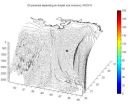(Press-News.org) Researchers at the University of Iowa have documented an activity by infants that begins nearly from birth: They learn by taking inventory of the things they see.
In a new paper, the psychologists contend that infants create knowledge by looking at and learning about their surroundings. The activities should be viewed as intertwined, rather than considered separately, to fully appreciate how infants gain knowledge and how that knowledge is seared into memory.
"The link between looking and learning is much more intricate than what people have assumed," says John Spencer, a psychology professor at the UI and a co-author on the paper published in the journal Cognitive Science.
The researchers created a mathematical model that mimics, in real time and through months of child development, how infants use looking to understand their environment. Such a model is important because it validates the importance of looking to learning and to forming memories. It also can be adapted by child development specialists to help special-needs children and infants born prematurely to combine looking and learning more effectively.
"The model can look, like infants, at a world that includes dynamic, stimulating events that influence where it looks. We contend (the model) provides a critical link to studying how social partners influence how infants distribute their looks, learn, and develop," the authors write.
The model examines the looking-learning behavior of infants as young as 6 weeks through one year of age, through 4,800 simulations at various points in development involving multiple stimuli and tasks. As would be expected, most infants introduced to new objects tend to look at them to gather information about them; once they do, they are "biased" to look away from them in search of something new. In other words, an infant will linger on something that's being shown to it for the first time as it learns about it, and that the "total looking time" will decrease as the infant becomes more familiar with it.
But the researchers found that infants who don't spend a sufficient amount of time studying a new object—in effect, failing to learn about it and to catalog that knowledge into memory—don't catch on as well, which can affect their learning later on.
"Infants need to dwell on things for a while to learn about them," says Sammy Perone, a post-doctoral researcher in psychology at the UI and corresponding author on the paper.
To examine why infants need to dwell on objects to learn about them, the researchers created two different models. One model learned in a "responsive" world: Every time the model looked away from a new object, the object was jiggled to get the model to look at it again. The other model learned in a "nonresponsive" world: when this model looked at a new object, objects elsewhere were jiggled to distract it. The results showed that the responsive models"learned about new objects more robustly, more quickly, and are better learners in the end," says Perone, who earned his doctorate at the UI in 2010.
The model captures infant looking and learning as young as 6 weeks. Even at that age, the UI researchers were able to document that infants can familiarize themselves with new objects, and store them into memory well enough that when shown them again, they quickly recognized them.
"To our knowledge, these are the first quantitative simulations of looking data from infants this young," the authors write.
The results underscore the notion that looking is a critical entry point into the cognitive processes in the brain that begin in children nearly from birth. And, "if that's the case, we can manipulate and change what the brain is doing" to aid infants born prematurely or who have special needs, Perone adds.
"The promise of a model that implements looking as an active behavior is that it might explain and predict how specific manipulations of looking over time will impact subsequent learning," the researchers write.
INFORMATION:
The research was funded by the National Institutes of Health, grant number: 5R01MH62480.
Infants learn to look and look to learn
2012-12-04
ELSE PRESS RELEASES FROM THIS DATE:
Improving chemotherapy effectiveness by acting on the immune system
2012-12-04
This press release is available in French. These results reveal how the immune system can then limit the effectiveness of some cancer chemotherapies. The researchers now intend to block the molecules responsible for negative immune system activation to increase the efficiency of chemotherapy. A clinical trial to test this hypothesis should begin very soon.
Chemotherapy is one of the most frequently used treatments to eliminate cancerous cells. These drugs kill all cells that are multiplying, or block their proliferation (for example, cells responsible for hair growth, ...
Numerical study suggests subsea injection of chemicals didn't prevent oil from rising to sea surface
2012-12-04
MIAMI — December 4, 2012 - The 2010 blowout of the Macondo well in the waters of the Gulf of Mexico resulted in the region's largest oil spill in U.S. history. As the Deepwater Horizon (DWH) incident unfolded, in an effort to prevent the oil from coming to the surface and reaching coastal and marsh ecosystems, chemical dispersants were injected at the wellhead. These powerful dispersants, typically used to break up oil slicks at the sea surface had never been used in such large quantities and over such a prolonged period of time in the deep ocean.
A new study published ...
New study reveals lions are rapidly losing ground in Africa
2012-12-04
A new study released this week confirms that lions are rapidly and literally losing ground across Africa's once-thriving savannahs due to burgeoning human population growth and subsequent, massive land-use conversion. Representing the most comprehensive assessment of the state and vitality of African savannah habitat to date, the report maintains that the lion has lost 75% of its original natural habitat in Africa – a reduction that has devastated lion populations across the continent.
Co-authored by Panthera's Lion Program Survey Coordinator, Dr. Philipp Henschel, and ...
Annals of Internal Medicine tip sheet for Dec. 4, 2012
2012-12-04
1. American College of Physicians Says Upper Endoscopy Overused in Patients with Reflux
Routine use of upper endoscopy for most patients with gastroesophageal reflux disease (GERD) does not improve patient health, is associated with preventable harms, and may lead to unnecessary interventions and costs, says the American College of Physicians (ACP) Clinical Guidelines Committee in a new evidence-based clinical policy paper. Heartburn, a symptom of GERD, is a common reason for people to see a doctor. Long term complications of GERD can include scarring of the esophagus ...
American College of Physicians: Upper endoscopy is overused in patients with heartburn
2012-12-04
PHILADELPHIA, December 4, 2012 -- Heartburn is one of the most common reasons for people to see a doctor, and some physicians often use upper endoscopy to diagnose and manage gastroesophageal reflux disease (GERD). But most patients do not require the procedure unless other serious symptoms are present, according to the American College of Physicians (ACP) Clinical Guidelines Committee in a new evidence-based clinical policy paper published today in Annals of Internal Medicine.
"The evidence indicates that upper endoscopy is indicated in patients with heartburn only when ...
Healthy eating beneficial beyond drug therapy in preventing a second heart attack
2012-12-04
Hamilton, ON (Dec. 3, 2012) - A heart-healthy diet rich in fruits, vegetables and fish significantly reduces the chance of a second heart attack and stroke in people with cardiovascular disease, McMaster University researchers have found.
A five-year study of almost 32,000 patients (average age 66.5 years) in 40 countries discovered those who ate a heart-healthy diet had a:
35 per cent reduction in risk for cardiovascular death
14 per cent reduction in risk for new heart attacks
28 per cent reduction in risk for congestive heart failure
19 per cent reduction ...
Healthy diet may help prevent recurrent heart attacks, strokes
2012-12-04
If you have cardiovascular disease, a heart-healthy diet may help protect you from recurrent heart attacks and strokes, according to new research in the American Heart Association journal Circulation.
"At times, patients don't think they need to follow a healthy diet since their medications have already lowered their blood pressure and cholesterol — that is wrong," said Mahshid Dehghan, Ph.D., study author and a nutritionist at the Population Health Research Institute, McMaster University in Hamilton, Ontario, Canada. "Dietary modification has benefits in addition to those ...
Social media may help fight childhood obesity
2012-12-04
Social media may be an effective tool to help children overcome obesity, according to a new American Heart Association scientific statement.
The statement is published online in the association's journal Circulation.
"Online communication and social media are an increasing part of our lives and our overall social network of family, friends and peers," said Jennifer S. Li, M.D., M.H.S., chair of the writing group. "Healthcare providers should embrace its potential as a tool for promoting healthy behavioral change."
The writing group evaluated research on Internet-based ...
New findings on glucagon synthesis
2012-12-04
Researchers at Karolinska Institutet in Sweden have shown that the cells that produce glucagon are stimulated by the hormone itself. A previous study by the same group demonstrated that this principle also applies to insulin. This means that a feedback system is at work in the body, whereby hormone secreting cells receive an immediate signal to produce more of the hormone.
While insulin is a hormone that lowers the level of glucose in the blood, glucagon is a hormone that increases it. Associate Professors Barbara and Ingo Leibiger and Professor Per-Olof Berggren at ...
Why older adults become fraud victims more often
2012-12-04
Why are older people especially vulnerable to becoming victims of fraud? A new UCLA study indicates that an important clue may lie in a particular region of the brain that influences the ability to discern who is honest and who is trying to deceive us.
Older people, more than younger adults, may fail to interpret an untrustworthy face as potentially dishonest, the study shows. The reason for this, the UCLA life scientists found, seems to be that a brain region called the anterior insula, which is linked to disgust and is important for discerning untrustworthy faces, ...



